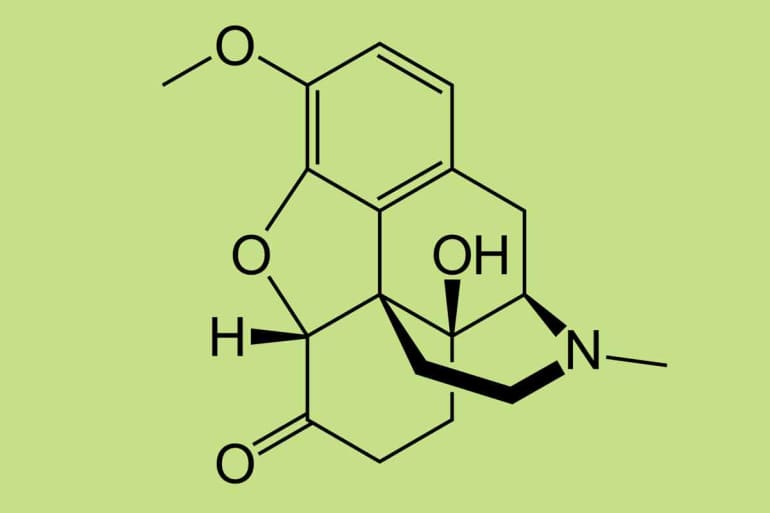What is Oxycodone?
Oxycodone is a prescription medication used to relieve moderate to severe pain. It comes in different forms that are used to treat different conditions and varying levels of pain. When used as prescribed, oxycodone is a highly beneficial drug for people suffering from conditions that cause chronic, lasting pain. Its strong effects offer them some relief.
At the same time, oxycodone is a powerful drug that can cause physical dependence and addiction when misused. You should never use oxycodone without a prescription and your doctor’s approval. Abusing the drug comes with severe risk and can lead to serious long-term health effects, including death.
Continue reading to learn more about what oxycodone is, its effects, why people use it, the dangers of use, and more.
What is Oxycodone Made Of?
Oxycodone is a semi-synthetic opioid which means it is partially natural and partially human-made. The medication is derived from the poppy plant, made from an organic alkaloid called thebaine. This stimulatory chemical is the base of the drug then manufacturers alter the chemical structure to include its depressant effects. Oxycodone’s chemical name comes from codeine because the two drugs have very similar structures. It is also similar to the drug hydrocodone.
Is Oxycodone an Opioid?
Oxycodone is an opioid, classified as a semi-synthetic opioid agonist. It interacts with and activates opioid receptors throughout the body to relieve severe pain. It’s part of the class of drugs derived from the opium poppy plant that are used for their intense depressant effects.
Since oxycodone is an opioid, it also comes with the dangerous effects that other opioids have. There is a high potential for misuse, abuse, and addiction. Oxycodone is one of the major medications associated with the opioid crisis that’s gripping the United States. Developing a tolerance is a serious concern for individuals using the drug both as prescribed and especially recreationally.
Chemistry of Oxycodone
The chemistry of oxycodone is similar to other derivatives of the opioid alkaloid, thebaine, like hydrocodone and morphine. Its chemical structure also resembles that of codeine with only slight differences. Oxycodone functions by binding to mu-receptors in the central nervous system (CNS) which causes its analgesic effects.

The medication inhibits the release of some neurotransmitters including gamma-aminobutyric acid (GABA), dopamine, and noradrenaline. It also stops the release of insulin, somatostatin, vasopressin, and glucagon. The chemistry of oxycodone ultimately results in its strong pain management properties.
Is Oxycodone Legal?
Oxycodone is legal when used with a prescription from a physician. Doctors can prescribe its use in situations where more mild approaches to pain management are not effective. It may be used both under medical supervision as well as for take-home use when prescribed.
At the same time, oxycodone is also a controlled substance with the Drug Enforcement Administration (DEA). The DEA classifies oxycodone as a Schedule II controlled substance. This means it has a high potential for abuse and may lead to psychological or physical dependence. Oxycodone, like other opioids, is a narcotic medication.
Oxycodone is not legal when used without a prescription. This includes anything outside of prescribed medical use. For example, taking more than the prescribed dose of oxycodone is illegal. Taking the medication from a friend or family member is also against the law. Additionally, purchasing oxycodone on the street for recreational use is not only illegal but also dangerous.

Medical detox is the first part of a comprehensive addiction treatment plan. Learn more about the role of medical detox in treating alcohol and drug addiction.
More infoWhat is Oxycodone Used For?
The primary use for oxycodone is as a pain management medication. It alleviates moderate to severe acute pain to help manage individuals who experience cancer-related and chronic pain. When used as prescribed, oxycodone improves the quality of life for people who are otherwise constantly plagued by pain.

Oxycodone is also used for recreational purposes by people looking to get high. The opioid drug causes pleasurable euphoric effects when taking more than the recommended doses. Recreational use is habit-forming and can quickly turn into a full-blown addiction with lasting consequences.
Medical Uses
Medical uses for oxycodone are primarily related to pain relief and pain management. Individuals who live with ongoing levels of moderate to severe pain are primary candidates for the medication. It offers both short-term and extended relief of pain caused by cancer or other chronic conditions.
Clinicians usually start treatment with a more mild medication. Once these milder medications prove to be of little help, care then transitions over to using oxycodone. Oxycodone serves as an alternative to other powerful opioid medications such as morphine or hydromorphone.
Other Uses
The other primary use of oxycodone is as a recreational drug. People turn to oxycodone for its calming, euphoric effects. Use may start as an enjoyable way to relax and unwind but can easily spiral out of control. Oxycodone is a strong medication and tolerance develops quickly which can eventually progress into dependence and addiction.
Recreational use of oxycodone is not only illegal but also dangerous. Misusing prescription opioids can cause a range of short- and long-term health effects. There is also a serious risk of overdose for those who abuse oxycodone or mix it with other substances.
What Is the Difference Between Oxycodone and Hydrocodone?
Both oxycodone and hydrocodone are two standard medications used to relieve pain. Oxycodone includes name brands like Percodan, Percocet, Roxicet, and OxyContin. Hydrocodone is found in medications like Norco, Vicodin, Lorcet, and Hycodan. Both are used to treat pain so what is the difference between oxycodone and hydrocodone?
Oxycodone and hydrocodone are only available by prescription from a doctor. Both interrupt pain signals in the central nervous system and prevent them from reaching the brain. Oxycodone and hydrocodone are also both classified as Schedule II substances by the Drug Enforcement Agency.
The differences between oxycodone and hydrocodone are very small. One study showed that both oxycodone and hydrocodone were equally effective at treating pain from acute fractures. But patients who took hydrocodone were more likely to experience constipation. A different study showed that oxycodone was 1.5 times more potent than an equal dose of hydrocodone.
Another difference between oxycodone and hydrocodone is some of the side effects. Oxycodone is more likely to cause dizziness and drowsiness, fatigue, headaches, and some feelings of euphoria. On the other hand, hydrocodone is more likely to cause constipation and stomach pain.
What Does Oxycodone Do?
The primary function of oxycodone is to relieve pain. It serves to relieve moderate to severe pain for people with both acute and chronic pain. Oxycodone is a powerful medication and its pain-relieving effects prove to be very effective in both inpatient and outpatient settings. But what exactly does oxycodone do?

How Oxycodone Works
Since it’s a semi-synthetic opioid, oxycodone works by binding to opioid receptors in the body. It inhibits the central nervous system from passing pain messages to the brain which provides relief. The powerful effects of oxycodone can be habit-forming and developing dependence is possible, especially when not taken as prescribed or used recreationally.
How Long Does it Take for Oxycodone to Work?
The amount of time it takes for oxycodone to work depends on a few factors: the type of medication used and how you take the medication. Taking oxycodone orally is the prescribed and most common way of use. When you orally ingest the liquid or capsule form of oxycodone it takes oxycodone about 30 to 60 minutes to work. The extended-release form of the medication takes a little bit longer for the effects to set in but usually works around the 60-minute mark.
How Long Oxycodone Lasts
The length of time oxycodone lasts depends on the type of medication you use. There are two main forms of oxycodone: short-release and extended-release. The effects of short-release oxycodone last between 4 to 6 hours before they start wearing off and you need to take another dose. The effects of extended-release oxycodone (OxyContin) last for up to 12 hours. Extended-release oxycodone is preferable in chronic pain situations because it reduces the frequency with which you need to take the medication.
How Long Does Oxycodone Stay in Your System?
The effects of Oxycodone last between 4 and 12 hours depending on the type of medication taken. Even after its effects wear off, though, Oxycodone stays in your system. There are a few different tests used to detect the presence of the medication. These tests can find traces of Oxycodone in your blood, urine, hair, and saliva.

The amount of time Oxycodone stays in your system depends on the type of drug screening used. Oxycodone clears fastest from your bloodstream and remains in your hair the longest. The amount of time the drug stays in your system is as follows:
- Blood: Up to 24 hours
- Saliva: Up to 4 days
- Urine: Up to 4 days
- Hair: Up to 90 days
These are only rough estimates of how long it takes your body to metabolize the entirety of the Oxycodone in your system. If you have to take a drug test within the first week after using the medication, there may still be signs of it in your system. There are various factors that affect how quickly your body metabolizes Oxycodone, such as:
- Age
- Sex
- Kidney function
- Liver impairment
- Alcohol
- Other medications
- Length of time using Oxycodone

Learn more about OxyContin, a powerful prescription opioid used to treat severe, long-term pain. It’s also a popular drug for recreational use and abuse. What is OxyContin? Uses, Side Effects, Contraindications, Dangers, and More.
More infoSide Effects
Oxycodone causes various side effects that range from mild to moderate to severe. The types and severity of side effects differ from person to person. There are many different side effects and people don’t usually experience every single one. Side effects of Oxycodone are typically most intense when first starting the medication then tend to even out over time.

Mild Effects
Mild effects are common and most people experience at least a few of them while using the medication. Some of the mild side effects of Oxycodone include:
- Dry mouth
- Flushing
- Stomach pain
- Headache
- Drowsiness
- Mood changes
Serious Effects
Other side effects of the medication are more serious. Not all of the following side effects cause immediate harm but should still be reported to a physician as soon as possible. Serious side effects of Oxycodone include:
- Nausea or vomiting
- Loss of appetite
- Weakness or dizziness
- Itchiness
- Hoarseness
- Hives
- Rash
- Swelling in the face, tongue, lips, throat, eyes, hands, lower legs, ankles, or feet
- Inability to achieve or maintain an erection
- Irregular menstruation
- Chest pain
- Difficulties breathing or swallowing
- Changes in heartbeat
- Lightheadedness
- Extreme drowsiness
- Agitation
- Hallucinations
- Confusion
- Loss of coordination
Contraindications and Dangers
Oxycodone isn’t always safe and there are certain situations when the medication shouldn’t be used. Using it in any way other than prescribed can lead to lasting or even fatal consequences. Additionally, there are patients for whom Oxycodone use is contraindicated. Conditions with contraindications for Oxycodone include:

- Hypersensitivity to Oxycodone
- Respiratory depression
- Chronic constipation
- Chronic obstructive lung disease
- Hypercarbia
- Severe bronchial asthma
- Elevated carbon dioxide levels in the blood
- Known or suspected gastrointestinal obstruction or ileus
There is also some research indicating potential contraindications for other opioids. People should never use Oxycodone while using other medications unless it’s cleared by their physician.
Oxycodone and Alcohol
You should never drink any amount of alcohol while taking Oxycodone. Taking a combination of these substances can cause serious and sometimes lethal consequences. Oxycodone and alcohol are both depressant substances that affect the central nervous system. Combining the drugs can have a synergistic effect which means the effects are stronger when used together.
Mixing Oxycodone and alcohol may cause serious effects including:
- Slowed heart rate
- Slowed breathing
- Respiratory arrest (stopping breathing)
- Stopping the heart
- Loss of consciousness
If someone experiences any of these effects, they should receive immediate medical attention. If the person doesn’t receive the necessary emergency medical services, the combination of Oxycodone and alcohol can be fatal.

Can You Overdose on Oxycodone?
Taking Oxycodone at normal prescribed doses should not result in an overdose. Unless combined with other substances, physicians will never prescribe dangerously high amounts of Oxycodone.
Using the drug recreationally is another story, though. People who use the drug to get high tend to take larger and larger doses over time. Taking Oxycodone at high doses can be dangerous or deadly. You can overdose on Oxycodone if you take more than your body is capable of processing at once.
People who partake in recreational use of Oxycodone are also at a greater risk of overdose because of how they use the drug. While people with a prescription ingest the medication orally, people who use it recreationally may also crush, break, or cut multiple Oxycodone pills and snort them. This delivers a dangerous, unmeasurable dose of the drug.
How Much Oxycodone Does It Take to Overdose?
Normal prescription levels of Oxycodone will not cause an overdose. So how much Oxycodone does it take to overdose? The answer is not exactly straightforward. Since people who use Oxycodone regularly develop tolerance, some can tolerate more of the drug than others.
For example, someone who has used Oxycodone for months or years can ingest more of the drug at once than someone using it for the first time. This makes it difficult to determine exactly how much Oxycodone it takes to overdose. However, a report from the Centers for Disease Control and Prevention states that individuals taking 60mg or more per day are more likely to die from an overdose.
Is Oxycodone Addictive?
Oxycodone is a powerful opioid medication which means it is both habit-forming and addictive. It’s recognized by the Drug Enforcement Administration for its high potential for abuse which may lead to severe psychological or physical dependence. Extended-release Oxycodone comes with an even greater possibility of developing an addiction.
The quick tolerance-building properties also make Oxycodone addictive. Since you need to take larger amounts over time to feel the same effects, it leads people down a dangerous path of taking more and more. This is especially true for people who use Oxycodone recreationally; they’re able to tolerate abnormally and dangerously high amounts of the drug.
Why is Oxycodone Addictive?
As your tolerance develops and you take more Oxycodone, you may feel its stronger effects from time to time. For example, taking large doses of Oxycodone use releases a surge of dopamine in your brain that causes feelings of euphoria. Some people enjoy this sensation and continue taking high doses to achieve it. Additionally, people who use Oxycodone recreationally are chasing after that euphoric high.
Despite the euphoria, the high that Oxycodone produces is still calm and relaxing. The drug also interacts with your brain’s reward system. Your brain realizes that taking Oxycodone leads to this enjoyable feeling. This leads people to keep taking the drug so they keep reaching that same high. Its powerful effects keep users coming back for more until they develop an Oxycodone addiction.
How Long Does It Take to Get Addicted to Oxycodone?
There is no single answer for how long it takes to get addicted to Oxycodone. Some people find themselves hooked within their first few times using the drug. Others develop an addiction to Oxycodone slowly over time. The time it takes for someone to become addicted depends on various factors such as:
- Age
- Gender
- Genetics
- Pre-existing medical conditions
- Previous problems with substance abuse or addiction
- Whether they’re mixing Oxycodone with other substances
Ultimately, how long it takes to develop an Oxycodone addiction is not as important. Focusing on the addiction problem itself should be the priority. Once someone is addicted to Oxycodone it doesn’t matter what it took to get there. What matters is making sure they receive the care and help they need.
Addiction to Oxycodone
Not everyone who uses Oxycodone will develop an addiction to the drug. Most people who receive a prescription for the medication use it as prescribed then stop using it when they no longer need it. Even people who develop a tolerance or dependence don’t necessarily cross the line and develop an addiction to Oxycodone.

The defining characteristic of Oxycodone addiction use is compulsive with little or no regard for consequences that happen. Someone with an addiction will continue using the drug even as problems start to pile up in their personal or professional life.
Overcoming an addiction to Oxycodone isn’t as simple as “just quitting.” Addiction is a chronic, progressive condition. After a certain point, people who are addicted to drugs lose the power of choice over their use. How can someone with an Oxycodone addiction find the help they need?
How to Detox From Oxycodone
Detox is the first step to overcoming Oxycodone addiction. After using the drug for months or years, your body becomes dependent on the substance to function. Suddenly quitting causes you to go through a detox period as the last of the drug clears from your system. You experience physical and psychological symptoms, called withdrawal symptoms, during this time.
The detox period is an intense and often uncomfortable few days. Withdrawal symptoms can be mild or severe depending on factors like how much you used, how long you used for, or whether you mixed Oxycodone with other substances. Medical detox from Oxycodone uses medications to relieve some of the effects of these withdrawal symptoms.
Medical detox is available at many addiction treatment facilities around the country. If you’ve used Oxycodone for a long time, you’ll likely start with a stay in a detox program before moving into the next phase of treatment.
Oxycodone Withdrawal Symptoms
Medical detox is often necessary because of the possibility of experiencing Oxycodone withdrawal symptoms. Since Oxycodone is a prescription opioid, they’re similar to other opiate withdrawal symptoms. Symptoms range from mild to severe depending on factors like:
- Drug tolerance
- How long you used Oxycodone
- If you combined Oxycodone with other substances
- Whether you’re quitting “cold turkey” or tapering off
The longer you use the drug, the more intense your symptoms will be. Mild symptoms cause some discomfort but do not usually require medical attention. On the other hand, if you experience severe symptoms of Oxycodone withdrawal you should seek medical help.
Mild Oxycodone withdrawal symptoms include:
- Anxiety
- Restlessness
- Dilated pupils
- Runny nose
- Watery eyes
- Goosebumps
- Sweating
- Yawning
- Body aches
- Abdominal cramps
- Vomiting
- Diarrhea
- Tremors or shakes
- Rapid heart rate
- High blood pressure
- Insomnia
Severe Oxycodone withdrawal symptoms include:
- Dehydration
- Hallucinations
- Seizures
Withdrawal symptoms tend to begin within 12 hours after taking the last dose of Oxycodone. The withdrawal period lasts between a few days and 2 weeks depending on the severity of symptoms and the factors listed above.
How to Treat Oxycodone Addiction
Some people can quit using Oxycodone on their own if they haven’t used it for very long. Many others find they cannot stop using the drug without outside help. One of the best ways to treat Oxycodone addiction is at a specialized addiction treatment facility. These facilities exist to not only to separate people from drugs and alcohol but help them learn to live sober.
Treatment facilities often make the detox period as manageable as possible by using medication-assisted treatment. This involves using different prescription medications to relieve the effects of Oxycodone withdrawal and make the process more comfortable. These medications can also reduce cravings for Oxycodone and other drugs.
Oxycodone addiction is a serious condition, though, and separating from the drug is only the first step. Treating Oxycodone addiction also involves an entire mindset shift. After using drugs for months or years it feels almost impossible to live without them. Addiction treatment also equips individuals with the tools to lay a solid foundation for a life of lasting recovery.
Trying to treat Oxycodone addiction by quitting cold turkey only addresses half of the problem. Without developing the tools and skills needed to stay clean and sober, relapse is often inevitable.
Where to Treat Oxycodone Addiction
There are facilities across the United States that treat Oxycodone addiction and other drug and alcohol use disorders. If you’re looking for one of the best programs available to help you overcome your addiction to Oxycodone, Hawaii Island Recovery is a fantastic option.
Located on the Big Island of Hawaii, our facility places you in the middle of a calm, serene environment. Your recovery and wellness are your only focus here at Hawaii Island Recovery. We use a combination of treatment modalities individualized to fit your specific needs.
If you’re ready to take the next step to overcome addiction, reach out to Hawaii Island Recovery. We can answer any questions or concerns you may have, or get you set up for the program that best fits your situation. Make the decision to take control back from Oxycodone addiction today!
Get Addiction Help!
If you or a loved one need help, call Hawaii Island Recovery toll-free right now.
866-390-5070 Hawaii Island Recovery
Hawaii Island Recovery 










